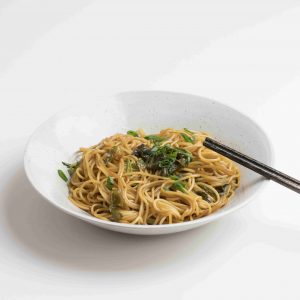This dish is popular in the whole region around Shanghai, where it is cherished as a quick and easily prepared meal and usually served with a fried egg. The essence of this dish lies in its simplicity. As such, it is the Chinese equivalent of the Italian Pesto.
What makes it so enticing, is the combination of the fragrance of spring onion simmered in oil with the umami flavor of the soy sauce. As the soy sauce simply invigorates this meal, it is proof of how much depth and flavor a high quality soy sauce can add in a simple dish. Spring onion oil is also a delicious companion with other dishes, as it may also serve as a salad dressing and dipping sauce. Thus, it is worth making greater quantities of the oil and storing it in the refrigerator which makes it a convenient condiment for a fast paced lifestyle.
Note: The quantities of spring onion and rapeseed oil account for an entire jar of spring onion oil (for 6 servings).
Cut the spring onion into abound 10 cm long pieces. Split the white part of the spring onion through the middle. Take one of the green pieces and cut it in small pieces. These pieces will be used as garnish in the end.
Heat up the oil to 100 degrees and then turn the heat down. First, fry the white part of the spring onion at a low heat. When the spring onion is becoming soft and transparent, add one batch of the green spring onion pieces. After this batch has become soft, add another batch of green onion pieces. Note that this process of preparing the spring onion oil takes a bit of patience. Yet, it is important to let the spring onion simmer in oil for a longer time at a low heat for the flavor to fully unleash. When the spring onions turn gold brown, turn the heat off. The entire process takes around 10 minutes. After the oil has cooled down, it can be stored in a jar and kept in the fridge for more than one week.
Add the soy sauce together with a pinch of sugar and salt into the serving bowls. After making sure the noodle is no longer watery, dish the serving bowls with the noodle, drizzle a few tablespoons of oil on it and add the oil infused spring onions. Mix everything evenly. Finally, add the spring onions for garnish.
With a simple cucumber salad or light side dish, the dish is ready to enjoy!
About the Noodles:
In the traditional Chinese recipe, fresh or dried wheat noodles are used. Buckwheat noodles also go well. If the asian-style noodles are hard to find, you can also use extremely slim spaghetti.
About the Soy Sauce:
In China, people use short term fermented soy sauce and aged soy sauce together, which produces a rich umami flavor and a beautiful color. The equivalent to this would be the Japanese Usukuchi and Koikuchi. It is even better to use the double brewed Tsuru Bishio soy sauce, which is usually aged for four years. Another choice for a gluten free option is Ganko Tamari, which is fermented over 3 years.

Die Nudeln mit Shoyu sind in der Region um Shanghai herum sehr populär, wo sie als eine schnell und einfach zuzubereitende Speise geschätzt werden.
Type: Main course
Cuisine: Shanghaiisch, Chinesisch
Keywords: Shoyu Nudel, Nudeln mit Sojasauce, Lauchzwiebel Nudeln, Chinesische Nudeln
Recipe Yield: 2
Preparation Time: PT0H10M
Cooking Time: PT0H10M
Total Time: PT0H20M
Recipe Video Name: Noodles with Shoyu and Spring Onion Oil
Recipe Video Description: This dish is popular in the whole region around Shanghai, where it is cherished as a quick and easily prepared meal and usually served with a fried egg.
Recipe Ingredients:
Recipe Instructions:
Lauchzwiebeln simmern:
Anrichten: